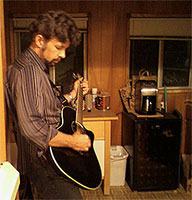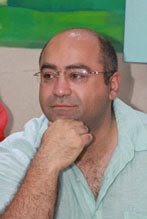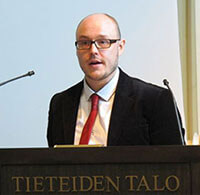| Library of Social Science: The Hub for Research on Warfare and Sacrifice |
| Library of Social Science is the hub for scholarship on the dynamics of warfare and its relationship to sacrifice (see the recent article in The New York Times). Our objective is to generate research and interaction among the most creative and dynamic scholars writing on this topic.
We scanned our Ideologies of War and Book Review websites, selected the best and most relevant writings—and created a new Website, War as Sacrifice. We have reproduced this website directly below.
| SCROLL DOWN THE PAGE FOR A COMPLETE LIST OF PAPERS, ESSAYS AND BOOK REVIEWS. PLEASE CLICK ANY ARTICLE’S LINK TO READ THE COMPLETE TEXT. |
Authors whose writings appear on this website (many of whom have written pieces especially for Library of Social Science) include:
• Scott Atran
• Kelly Denton-Borhaug
• Yael Feldman
• Roger Griffin
• Nicoletta Gullace
• Stanley Hauerwas
• Paul Kahn
• Richard Koenigsberg
• Renee Lockwood
• Carolyn Marvin |
• Agnieszka Soltysik Monnet
• Babak Rahimi
• Michael Roberts
• Rana Salimi
• Ivan Strenski
• Tuomas Tepora
• Brian Victoria
• Michael Vlahos
• David Weddle
• Pingchao Zhu |
Are there papers or book reviews we are missing that belong on this site? Please send your suggestions to Oanderson@libraryofsocialscience.com. We hope you will participate in this important project. We will be grateful for your contribution. |
| War as Sacrifice |
Atran, Scott
- For Cause and Comrade: Devoted Actors and Willingness to Fight (Paper)
“This report provides initial evidence that 'devoted actors' who are unconditionally committed to a sacred comrades, willingly make costly sacrifices—including fighting and dying.”
- Reframing Sacred Values (Paper)
“People believe that devotion to essential or core values—such as the welfare of their family and country, or their commitment to religion, honor, and justice—are absolute and inviolable.”
|
Azzam, Shiekh Abdullah
- Martyrs: The Building Blocks of Nations (Lecture)
“History does not write its lines except with blood. Glory does not build its loft edifice except with skulls, Honour and respect cannot be established except on a foundation of cripples and corpses.”
|
Baird, J. W.
- To Die For Germany: Heroes in the Nazi Pantheon (Book Excerpts)
“During the Great War, propagandists and poets alike joined hands in exalting the blood sacrifice of the youth of Germany, thus transforming carnage into ethereal national revelation.”
|
| Brænder, Morton
|
 |
Bryson, Michael
|
 |
Denton-Borhaug, Kelly
|
 |
Elshtain, Jean Bethke
- Identity, the State and Sacrifice
The Sovereign may bear a masculinized 'face' but the nation itself is feminized, a mother, a sweetheart, a lover. One can rightly speak, as Anderson does, of "political love, a love that retains the fraternal dimensions of medieval caritas,” but incorporates as well a maternalized loyalty symbolized domestically. The nation is home and home is mother. No more than one chooses one's parents does one choose one's country and this adds even greater force to the nature of political love. We fall in love early through language, "encountered at mother’s knees and parted with only at the grave,” and through this language "pasts are restored, fellowships are imagined, and futures dreamed."
|
 |
Feldman, Yael S.
|
Fornari, Franco
- The Psychoanalysis of War (Book Excerpts)
“War is a spectacular establishment of a general human situation whereby death assumes absolute value: the ideas for which we die have a right to truth, because death becomes a demonstrative process.”
|
 |
Griffin, Roger
- The Meaning of ‘Sacrifice’ in the First World War
It was as if the fantasy of redemption through sacrifice—stubbornly entertained by both fighters and onlookers—was fueled rather than quenched by the blood of the fallen, like pouring oil on flames. The whole war can be seen as a collective act of redemptive self-sacrifice—transcendent meaning produced by the relentless flow of blood.
|
 |
Gullace, Nicoletta
- White Feathers and Wounded Men: Female Patriotism and the Memory of the Great War
On August 30, 1914, Admiral Charles Penrose Fitzgerald, an inveterate conscriptionist and disciple of Lord Roberts, deputized thirty women in Folkstone to hand out white feathers to men not in uniform. The purpose of this gesture was to shame "every young 'slacker' found loafing about the Leas" and to remind those "deaf or indifferent to their country's need" that "British soldiers are fighting and dying across the channel."
|
| Hart, David
|
| Hauerwas, Stanley
|
Holmes Jr., Oliver Wendell
- The Soldier's Faith (Speech)
“In the midst of doubt, the collapse of creeds, there is one thing I do not doubt, and that is that the faith is true and adorable which leads a soldier to throw away his life in obedience to a blindly accepted duty, in a cause which he little understands, in a plan of campaign of which he has little notion, under tactics of which he does not see the use.”
|
| Howard, Michael
|
Kahn, Paul
- Political Evil: Killing, Sacrifice, and the Image of God (Chapter 5 of Out of Eden)
“The willingness to sacrifice for the creation and maintenance of political meanings always appears inconceivable to those outside of the community.”
- Torture and International Law (Chapter 2 of Sacred Violence)
“We have not so much abandoned the practice of torture as shifted its locus. The battlefield is strewn with the disemboweled and beheaded, with severed limbs and broken bodies. All have died a terrible death in a display of sovereign power. To view the battlefield is to witness the awesome power of the sovereign to occupy and destroy the finite body; to stand before the modern, democratic equivalent of the spectacle of the scaffold.”
|
 |
Koenigsberg, Richard
A.
- As the Soldier Dies, so the Nation Comes Alive
- Aztec Warriors/Western Soldiers
The First World War was undertaken and perpetuated under the assumption that the “lives” of nations were more significant than the lives of human beings. Germany, France and Great Britain were fed with the bodies and blood of soldiers—sacrificial victims—in order to keep these entities alive. “The individual must die so that the nation might live” is a phrase that has been uttered throughout the history of warfare. What does this mean? The First World War represented an enactment of this proposition: the nation was imagined to come alive insofar as individuals died—was fed with the bodies and blood of sacrificed soldiers.
- Civilization and Sacrificial Death
The evidence indicates that Hitler waged war in order to sacrifice the German people. His was an ideology of death: kill others (the nation’s “enemies”), then act to bring about the destruction of Germany. There is not a single sentence in Mein Kampf about “conquest.” Of course, most people embrace the shared fantasy of Hitler as a failed conqueror. It also seems as if the sun revolves around the earth.
- First World War as Sacrificial Ritual (May, 2016)
- First World War as Sacrificial Ritual (October, 2014)
- History and Sacrificial Death
The creation of 'History' requires: (1) Political leaders who persuade human beings to perform acts of violence. (2) People (journalists and historians) who record performances of political violence. It is not as if the violent acts that constitute history are separate from the recording of these acts. Journalists and historians are active participants, not bystanders. Their role is to 'witness' violent political acts, and thus to create 'history' by recording them.
- Review Essay of Walter A. Skya's Book Japan's Holy War: The Ideology of Radical Shinto Ultranationalism
To achieve the state of “one heart, same body,” the individual had to discard or annihilate the self. Any consideration of one’s own personal needs was wrong: one had to totally submerge the self into the collectivity. When Kakehi spoke of the bad aspects of Western culture that had entered Japan, he was referring to the evils of Western secularism and individualism. The Western focus on the value of the individual was the “greatest threat to the Japanese nation.”
- Review Essay on Steven E. Miller, Sean M. Lynn-Jones, and Stephen Van Evera's Book Military Strategy and the Origins of the First World War
The ideology of the offensive at all costs grew out of the desire to demonstrate the moral courage and will of one’s troops, and therefore the greatness of one’s nation. Such a strategy rarely resulted in breakthroughs. By virtue of attacking—even when slaughter was the result—soldiers exemplified the will to national self-sacrifice for the sake of one’s nation.
- The Law of Sacrifice
- The Soldier as Sacrificial Victim
Hypocrisy lies at the heart of the institution of warfare. People plug into the spectacle and relish the fantasy of their nation's power and glory. They embrace war as a righteous struggle between good and evil. However, most people themselves do not wish to be put in harm's way. War is enjoyable to the extent that killing, suffering and dying are delegated to someone else. Further, people would rather that the carnage take place somewhere else.
|
 |
Library of Social Science/Anderson, Orion
|
| Linderman, Gerald F.
|
 |
Lockwood, Renee
- Sacrifice and the Creation of Group of Identity: Case Studies of Gallipoli and Masada
It has often been acknowledged that nations are born of war. Yet recent scholarship suggests that it is not the sacrifice of the enemy that creates a unified group identity, but the sacrifice of the group’s own. This essay demonstrates the truth of this hypothesis on the basis of two primary case studies: the ‘sacrifices’ made at Gallipoli and Masada.
|
| Marvin, Carolyn
|
McPherson, James
- For Cause and Comrades: Why Men Fought in the Civil War (Book Excerpts)
“Civil War soldiers wrote much about courage, bravery, valor—the mark of honor. But they wrote even more about cowardice—the mark of dishonor. Most wanted to avoid the shame of being known as a coward—this is what gave them courage. Civil War soldiers went forward into a hail of bullets because they were more afraid of showing the ‘white feather’ than they were of death.”
|
| Moghadam, Assaf
|
| Monnet, Agnieszka Soltysik
|
| Mosse, George L.
|
 |
Rahimi, Babak
- The Transhuman Soldier: A Comparative Look at World War I and the Iran-Iraq War
With his sacrifice, the soldier transforms the ordinary cycle of existence into something livelier and more transhuman. His sacrifice on the battlefield becomes a creative event to conquer death. He attains a sacred quality with his ability to generate an all-too-superhuman vitality, a sacred death of transcendental reality. The act of sacrifice empowers the self of a soldier against the natural process of demise—and towards the creation of a transcendent entity.
|
| Ricks, Steven D.
|
| Roberts, Michael
|
| Sagan, Eli
|
 |
Salimi, Rana
- Review Essay of Mark Schantz's Book Awaiting the Heavenly Country: The Civil War and America's Culture of Death
The political system of U.S. society in the Civil War era demanded that its citizens sacrifice their lives and commit violence against their fellow countrymen so the nation as a whole could survive. The dominant religious ideology of the time required citizens to voluntarily exchange the mundane world for the heavenly rewards of the afterlife. The individual could achieve the eternal life in heaven and could be commemorated as a hero if he was ready to sacrifice himself.
|
| Seitz, David W.
|
| Stalbank, Chris
|
 |
Strenski, Ivan
- Sacrifice: Bad Math, Bad Grammar
Sacrifice means loss, giving up, destruction and death. But, much talk about sacrifice carries on as if this loss, this subtraction, actually achieves addition. The soldier ‘sacrifices’ themselves in battle, but this doesn’t count as diminishment. It actually adds to whatever social body of reference is in play. So, the question is why and how can sacrifice add to the social whole, when, in the fact of destruction and death, it subtracts from the social whole, by removing one of its members from the body of the living?
- Sacrifice, Gift and the Social Logic of Muslim ‘Human Bombers’
To understand Muslim ‘human bombers’, we must see them within the discourse of jihad, but also within that of ‘sacrifices’ and ‘gifts’. ‘Human bombings’ are not, therefore, simply matters of utilitarian military tactics, but are also religious and social as gifts, martyrdoms and sacrifices. This article proposes that we need to pay greater attention to the ‘sacrificial’ designations of these ‘human bombings’ as made by Muslims and which are rooted in Islamic discourse.
|
| Swann Jr., William
|
| Szink, Terrence L.
|
| Tanaka, Yuki
|
 |
Tepora, Tuomas
- Redirecting Violence: The Finnish Flag as a Sacrificial Symbol, 1917-1945
National flags are essential in making sense of the citizens’ sense of belonging to the nation. National celebrations—as well as the routine, everyday ‘lagging’ of the nation in the media—form a context which shapes peoples’ experience of their environment. National flags represent the shared feelings and values of a collective, forming a link between civil society and the state.
|
| Terrell, Robert
|
| Victoria, Brian
|
 |
Vlahos, Michael
- D-Day (June 6, 1944), the Invasion of Normandy: “A moment of unique American sacrifice”
Michael Vlahos podcast on the John Batchelor radio show: “We had to create—not just a mythic moment—but a moment of unique American sacrifice. We managed to do that. As we look back, it is the great liturgy of the American experience—not just in World War II—but of the America that was born on that day. It’s a kind of high mass of the nation—of the American ethos.”
- Rites of Spring: Sacrifice, Incarnation, and War
The 20th century’s wars—from 1914-1951, and their aftermath—killed perhaps 150 million individual human beings. We casually ascribe this calamity to madness, evil, or the inevitable efficiencies of an industrial economy. Yet I argue that this killing was embedded in the desire of peoples to fulfill—through war—the vision that drove them. This was the paradoxical, unconfessed vision of Modernity—which replaced universal institutions of collective identity (for centuries vested in social order and Church) with a dynamic new alternative.
- Terrorism’s Sacred Heart: The Sacrifice
What makes terrorism so powerful is that it leverages the most powerful of human actions: the sacrifice. For thousands of years, human sacrifice has represented a sacred rite, with many layers of explicit ritual and symbol—in which our most precious loss transforms into our most precious gift. Think of the sacrifice—enacted and memorialized—as the mortar of our collective belief and belonging.
- The Ideology of Sacrifice is Hemorrhaging
In his essay, “The Rites of Spring,” Michael Vlahos stated that War in Modernity was an “extended ritual demanding mass sacrifice in which the literal ‘body and blood’ of millions at once renewed and re-fertilized the nation.” However, this national theology “no longer rules America as it once did.” The fervent faith of a whole nation—leading to sacrifice on the high altar—has been “emptied of belief.”
- Fighting Identity: Sacred War & World Change (Book Excerpts)
|
 |
Weddle, David
|
Weir, Peter
- Gallipoli (1981) - Ending (Video excerpt from Peter Weir’s film)
Several young men from rural Western Australia enlist in the Australian Army during the First World War. This scene depicts the film's sad ending.
- Gallipoli (1981) - Massacre (Video excerpt from Peter Weir’s film)
Depicts the charge at Nek at Gallipoli (August 7, 1915). Anzac troops are massacred by the Turks when they get out of the trench armed only with bayonets. This astonishing scene, according to Michael Vlahos, represents an accurate depiction.
|
 |
Zhu, Pingchao
- Mao’s Martyrs: Revolutionary Heroism, Sacrifice, and China’s Tragic Romance of the Korean War
China entered into the Korean War at a critical historical moment: the new Communist regime had just celebrated its first anniversary in October 1950. In military strength and industrial capacity, China was no match for its opponent, the well equipped and supplied United Nations Command (UNC) under the United States military command leadership. What China could rely on was its massive manpower and political propaganda—entrenched in the Marxist doctrine of anti-imperialism and internationalism.
|
|
|















